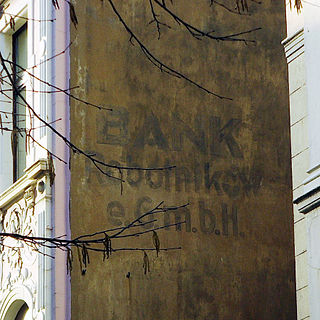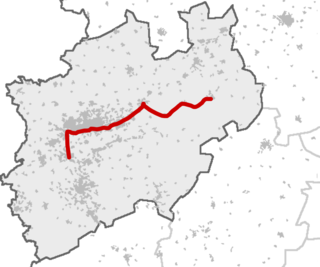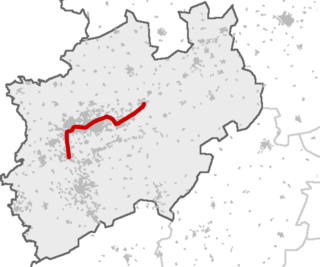
Rhineland-Palatinate is a western state of Germany. It covers 19,846 km2 (7,663 sq mi) and has about 4.05 million residents. It is the ninth largest and sixth most populous of the sixteen states. Mainz is the capital and largest city. Other cities are Ludwigshafen am Rhein, Koblenz, Trier, Kaiserslautern, Worms, and Neuwied. It is bordered by North Rhine-Westphalia, Saarland, Baden-Württemberg and Hesse and by France, Luxembourg and Belgium.

North Rhine-Westphalia or North-Rhine/Westphalia, commonly shortened to NRW, is a state (Land) in Western Germany. With more than 18 million inhabitants, it is the most populous state in Germany. Apart from the city-states, it is also the most densely populated state in Germany. Covering an area of 34,084 km2 (13,160 sq mi), it is the fourth-largest German state by size.

The Rhineland is a loosely defined area of Western Germany along the Rhine, chiefly its middle section. It is the main industrial heartland of Germany because its many factories and historic ties to the Holy Roman Empire, Prussia, German Empire and etc.

The Ruhr, also referred to as the Ruhr area, sometimes Ruhr district, Ruhr region, or Ruhr valley, is a polycentric urban area in North Rhine-Westphalia, Germany. With a population density of 2,800/km2 and a population of over 5 million (2017), it is the largest urban area in Germany and the third of the European Union. It consists of several large cities bordered by the rivers Ruhr to the south, Rhine to the west, and Lippe to the north. In the southwest it borders the Bergisches Land. It is considered part of the larger Rhine-Ruhr metropolitan region of more than 10 million people, which is the third largest in Western Europe, behind only London and Paris.

Duisburg is a city in the Ruhr metropolitan area of the western German state of North Rhine-Westphalia. Lying on the confluence of the Rhine and the Ruhr rivers in the center of the Rhine-Ruhr Region, Duisburg is the 5th largest city in North Rhine-Westphalia and the 15th-largest city in Germany.

Mülheim, officially Mülheim an der Ruhr and also described as "City on the River", is a city in North Rhine-Westphalia in Germany. It is located in the Ruhr Area between Duisburg, Essen, Oberhausen and Ratingen. It is home to many companies, and two Max Planck Institutes.

An urban area is a human settlement with a high population density and an infrastructure of built environment. This is the core of a metropolitan statistical area in the United States, if it contains a population of more than 50,000.

Mettmann is a town in the northern part of the Bergisches Land, in North Rhine-Westphalia, Germany. It is the administrative centre of the district of Mettmann, Germany's most densely populated rural district. The town lies east of Düsseldorf and west of Wuppertal.
Urban culture is the culture of towns and cities. The defining theme is the presence of a large population in a limited space that follows social norms. This makes it possible for many subcultures close to each other, exposed to social influence without necessarily intruding into the private sphere. Ultimately, urban culture offers for diverse perspectives, more resources in the medical field, both physically and mentally, but it also faces challenges in maintaining social cohesion.

The University of Duisburg-Essen is a public research university in North Rhine-Westphalia, Germany. In the 2019 Times Higher Education World University Rankings, the university was awarded 194th place in the world. It was originally founded in 1654 and re-established on 1 January 2003, as a merger of the Gerhard Mercator University of Duisburg and the university of Essen. It is based in both the cities of Duisburg and Essen, and a part of University Alliance Metropolis Ruhr.

Ruhrpolen is a German umbrella term for the Polish migrants and their descendants who lived in the Ruhr area in western Germany since the 19th century. The Poles migrated to the rapidly industrializing region from Polish-speaking areas of the German Empire.

Urbanization in China increased in speed following the initiation of the reform and opening policy. By the end of 2023, China had an urbanization rate of 66.2% and is expected to reach 75-80% by 2035.
The actual boundaries of the Ruhr vary slightly depending on the source, but a good working definition is to define the Lippe and Ruhr as its northern and southern boundaries respectively, the Rhine as its western boundary, and the town of Hamm as the eastern limit.

The Rhein-Hellweg-Express is a Regional-Express service in the German state of North Rhine-Westphalia (NRW), running from Kassel via Dortmund, Bochum, Essen, Duisburg and Düsseldorf Airport to Düsseldorf Hbf. It is named after the Rhine and the Westphalian Hellweg. The line is part of the Rhine-Ruhr Express (RRX) network and is operated by National Express.

The Rhein-Emscher-Express is a Regional-Express service in the German state of North Rhine-Westphalia (NRW), running from Düsseldorf via Duisburg, Gelsenkirchen and Dortmund to Hamm. It connects with the rest of the regional rail network of NRW in Düsseldorf, Duisburg, Oberhausen, Wanne-Eickel, Dortmund and Hamm. In addition, it connects in Düsseldorf, Duisburg, Oberhausen, Dortmund and Hamm with long-distance services.
The following is a timeline of the history of the city of Essen, Germany.

There is a Japanese community in Düsseldorf, Germany. The city and its surrounding regions has hosted Japanese companies since the 1950s, and as of 2021 there are 636 Japanese-related companies in the state of North Rhine-Westphalia. Around 7,000 (2021) Japanese nationals live in its capital city Düsseldorf.
The term useful Jew was used in various historical contexts, typically describing a Jew useful in implementing an official authority's policy, sometimes by oppressing other Jews.

The East German Republic Day Parade of 1989 was a parade on Karl-Marx-Allee in East Berlin on 7 October 1989 commemorating the 40th anniversary of the establishment of East Germany. This was the last East German Republic Day Parade and the last major East German political event with the regime falling mere weeks later. In Germany, this parade is remembered as the end of "the great period of military parades".
The Mölln arson attack was the first fatal case of far-right extremists setting fire to migrants' homes in Germany, and one of the earliest cases of Right-wing terrorism in the country's post-unification history. On the night of 22 November 1992, 2 German men with neo-Nazi ties set fire to the 2 houses of Turkish families in Mölln, in Schleswig-Holstein, Germany. 3 Turks died in the attack while 9 others were injured.















